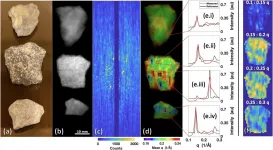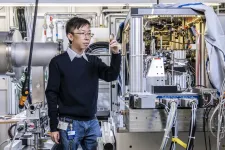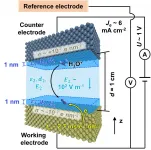(Press-News.org) DURHAM, N.C. - Engineers at Duke University have demonstrated a prototype X-ray scanning machine that reveals not just the shape of an object but its molecular composition. With unprecedented resolution and accuracy, the technology could revolutionize a wide range of fields such as cancer surgery, pathology, drug inspection and geology.
Many of the ideas behind the prototype were originally conceived in the pursuit of performing better bomb detection for aviation security. In the new paper, published online May 19 in the journal Scientific Reports, the researchers adapted the technology for several targeted scientific and medical applications.
"Whether you're trying to spot a bomb in a bag or a tumor in a body, the physics is more or less the same," said Joel Greenberg, associate research professor of electrical and computer engineering and faculty of the medical physics program. "But from an engineering point of view, the constraints on the two are very different. We built this smaller, higher-resolution device to demonstrate that our approach could be used for a number of different applications."
The technology is a hybrid X-ray system that combines conventional X-ray transmission radiography with X-ray diffraction tomography. The former involves measuring the X-rays that pass straight through an object. The latter involves gathering deflection angle and wavelength information from X-rays that have scattered (or bounced) off of an object, which provide a sort of "fingerprint" unique to that material's atomic structure.
One of the hurdles to adopting this technology is that the scattered X-ray signal is typically very weak and complex. This results in very few X-rays reaching the detector with each image captured, which leads to long delays while the scanner gathers enough data for the job at hand.
The Duke team's approach uses a coded aperture, a sort of pierced shield that allows X-rays travelling at many different angles to pass through its holes. The trick is in knowing the exact pattern being used to block the X-rays, which a computer can then use to process the larger, more complex signal. This allows the researchers to gather enough deflected X-rays to ID the material in a shorter time span.
In the paper, the researchers developed a new method for creating high-quality, 3D coded apertures, designed a new machine end-to-end with a user interface and compact footprint, and built a prototype using off-the-shelf components regularly used in medical imaging.
"Designing improved algorithms and implementing advanced manufacturing was essential to achieving the desired imaging performance" said Stefan Stryker, a PhD student and first author on the paper.
"Security scanning systems have different goals than an oncology lab," said Anuj Kapadia, who was an associate professor of radiology and faculty in Duke medical physics at the time of performing the research but is now at Oak Ridge National Laboratory. "Security systems need to peer through tens of centimeters of random objects in a matter of seconds, whereas our goal was to get a high-resolution image of a small, well-defined specimen with less of a time restraint."
The biggest challenge tackled by the prototype scanner involved making accurate diagnoses of potentially cancerous tissues. Working with colleagues at Duke Health, the researchers scanned tissue biopsies before they were sent to the resident pathologists for their clinical workups. The scanner not only matched the clinical diagnosis accurately, but it also reliably distinguished between the subtypes of tissue in and around the cancerous tissue.
"Our eventual goal is to have one of these scanners in every operating room so that surgeons can get an instantaneous diagnosis as soon as the cancer is removed, and they can immediately check to see if any cancerous cells are present on the edges," said Kapadia. "That way, if there's any suspicion that they missed some of the cancer, they can immediately go back and get the rest."
"While margins can often be evaluated by pathologists while the patient is still in the operating room, for tissues like breast, specimens removed at surgery require a 24-hour processing cycle before their margins can be properly assessed," said Shannon McCall, associate professor of pathology, vice chair for translational research in the department of pathology, and director of the Duke BioRepository & Precision Pathology Center (Duke BRPC). "If this new instrument allowed us to accurately assess the margins of these types of tissues while the patient was still in the operating room, that would be fantastic. Women could potentially be spared additional surgical procedures."
The researchers then showed that the scanner could provide a real-time analysis of pharmaceuticals. Not only could this help manufacturers ensure their product is reliable, but it could also be used by police forensics departments or public health campaigns to make sure people are not selling or overdosing on tainted drugs.
The scanner also proved capable of quickly analyzing rocks lent to them by an amateur collector, Greenberg's nine-year-old daughter, Madelyn. Such analyses could be useful for archaeologists studying fossils or miners making decisions about which ore to use in their extraction facilities.
Moving forward, the research team has a grant from the National Institutes of Health to optimize the scanner for tissue samples. Quadridox Inc., which was founded by Greenberg and Kapadia along with colleagues Michael Gehm (Duke) and Amit Ashok (University of Arizona), is pursuing translating the technology into products that might instead be optimized for larger rocks, quicker pharmaceutical scans or biospecimen analyses.
"We built this scanner to show all of the different types of things that it could accomplish," said Greenberg. "But a commercial machine for each application might have its own set of engineering variations, such as the way in which we make measurements, the choice of sensors or the architecture."
"If you were going to design a projector, you would need to know if it was going to be used in a dark theater or in broad daylight. The specifications would be completely different," added Kapadia. "Similarly here, our goal is to find many applications where these sorts of scans could be useful, and then engineer a variety of scanners to fit their specific needs."
INFORMATION:
This research was supported by the North Carolina Biotechnology Center (2018-BIG-6511) and the U.S. Department of Homeland Security (18STEXP00001-03-02).
CITATION: "X-Ray Fan Beam Coded Aperture Transmission and Diffraction Imaging for Fast Material Analysis," Stefan Stryker, Joel A. Greenberg, Shannon J. McCall & Anuj J. Kapadia. Scientific Reports 11, Article number 10585 (2021). DOI: 10.1038/s41598-021-90163-0
Watching honeybees buzz among flowers, it's easy to see how the expression "busy as a bee" arose. One of many movements a bee's body makes is the repetitive curving and straightening of its abdomen. Now, researchers reporting in ACS Applied Materials & Interfaces have found that tiny hairs reduce friction from these motions, saving energy for the industrious insects' daily activities while reducing wear and tear. This knowledge could help researchers design longer-lasting moving parts.
A bee's abdomen is divided into several tough outer plates that make up its exoskeleton. When the abdomen flexes and extends, these segments slide over each other, creating friction. However, the overlapping portions of the segments show very little wear and tear, ...
WASHINGTON, June 9, 2021 -- The World Health Organization and the Centers for Disease Control recommend keeping a certain distance between people to prevent the spread of COVID-19. These social distancing recommendations are estimated from a variety of studies, but further research about the precise mechanism of virus transport from one person to another is still needed.
In Physics of Fluids, by AIP Publishing, researchers from Stony Brook University, Harvard, ETH Zurich, and Hanyang University demonstrate normal breathing indoors without a mask ...
Summer rainfall on the Tibetan Plateau is highly predictable on multiyear timescales in large ensemble predictions, according to a research team led by ZHOU Tianjun from the Institute of Atmospheric Physics (IAP) of the Chinese Academy of Sciences.
The study, published in Science Advances on June 9, shows evidence that the predictable signal of summer rainfall across the hinterland of the Tibetan Plateau is substantially underestimated in state-of-the-art decadal prediction models.
The predictable signal is so weak that it can be concealed by unpredictable noise. "The too weak predictable signal arises from the low signal-to-noise ratios in models in comparison with the real world," ...
A new study at the University of Chicago Medicine and Washington University found that a single inhalation session with 25% nitrous oxide gas was nearly as effective as 50% nitrous oxide at rapidly relieving symptoms of treatment-resistant depression, with fewer adverse side effects. The study, published June 9 in Science Translational Medicine, also found that the effects lasted much longer than previously suspected, with some participants experiencing improvements for upwards of two weeks.
These results bolster the evidence that non-traditional treatments may be a viable option for patients whose depression is not responsive to typical antidepressant medications. It may also provide a rapidly effective treatment option for patients in crisis.
Often called "laughing gas," nitrous ...
A single, one-hour treatment that involves breathing in a mixture of oxygen and nitrous oxide -- otherwise known as laughing gas -- significantly improved symptoms in people with treatment-resistant depression, according to new data from researchers at Washington University School of Medicine in St. Louis and the University of Chicago.
In a phase 2 clinical trial, the researchers demonstrated that symptoms of depression improve rapidly following treatment with inhaled nitrous oxide. Further, they reported the benefits can last for several weeks.
The findings are published June 9 in the journal Science Translational Medicine.
"A large percentage of patients don't respond to standard antidepressant therapies -- the ...
A new study unexpectedly identified tiny deposits of elemental copper and iron within the brains of two deceased people with Alzheimer's disease. The findings could help scientists better understand how these elemental metals, which were uncovered in the cores of amyloid plaques, contribute to neurodegenerative diseases and could point to a target for alternative Alzheimer's therapies. While enzymes and proteins containing positively charged copper and iron ions have been known to control key processes in the human brain, little has been known about how the organ mineralizes iron and copper, including the formation of elemental metallic nanoparticles, which ...
(Boston)--Should treatment of alcoholics be different based on gender? Yes, according to a new study that shows that alcoholic men and women respond differently to their disease resulting in different levels of brain activity and brain abnormalities. Research indicates that they distinguish facial expressions differently and that this is an important clue as to how treatment strategies might be tailored.
Chronic long-term Alcohol Use Disorder (AUD) or "alcoholism," is a harmful condition that has been associated with deficits in emotion and memory, including memory for the emotional expressions of faces. In addition to its effects on memory for facial emotions, AUD also has been associated with impairments ...
PSI researchers have developed a new tomography method with which they can measure chemical properties inside catalyst materials in 3-D extremely precisely and faster than before. The application is equally important for science and industry. The researchers published their results today in the journal Science Advances.
The material group of vanadium phosphorus oxides (VPOs) is widely used as a catalyst in the chemical industry. VPOs have been used in the production of maleic anhydride since the 1970s. Maleic anhydride in turn is the starting material for the ...
Widespread adoption of hydrogen-powered vehicles over traditional electric vehicles requires fuel cells that can convert hydrogen and oxygen safely into water - a serious implementation problem.
Researchers at the University of Colorado Boulder are addressing one aspect of that roadblock by developing new computational tools and models needed to better understand and manage the conversion process. Hendrik Heinz, an associate professor in the Department of Chemical and Biological Engineering, is leading the effort in partnership with the University of California Los Angeles. His team recently published new findings on the subject in Science Advances.
Fuel cell electric vehicles combine ...
A single one-hour treatment with nitrous oxide - also known as laughing gas - can relieve symptoms of treatment-resistant depression for several weeks, according to a phase 2 clinical trial involving 28 participants. By showing that a 25% concentration of the gas still has therapeutic effects, the results suggest that lower concentrations of nitrous oxide could be useful against depression in the clinic while bringing a lower risk of side effects. Inhaled nitrous oxide is commonly used as a sedative agent in dental and medical offices, but the gas has also attracted attention as a possible treatment for depression. A previous study showed that nitrous oxide had marked ...





